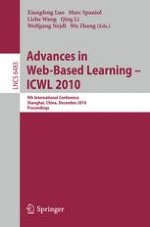2010 | Book
Advances in Web-Based Learning – ICWL 2010
9th International Conference, Shanghai, China, December 8-10, 2010. Proceedings
Editors: Xiangfeng Luo, Marc Spaniol, Lizhe Wang, Qing Li, Wolfgang Nejdl, Wu Zhang
Publisher: Springer Berlin Heidelberg
Book Series : Lecture Notes in Computer Science
